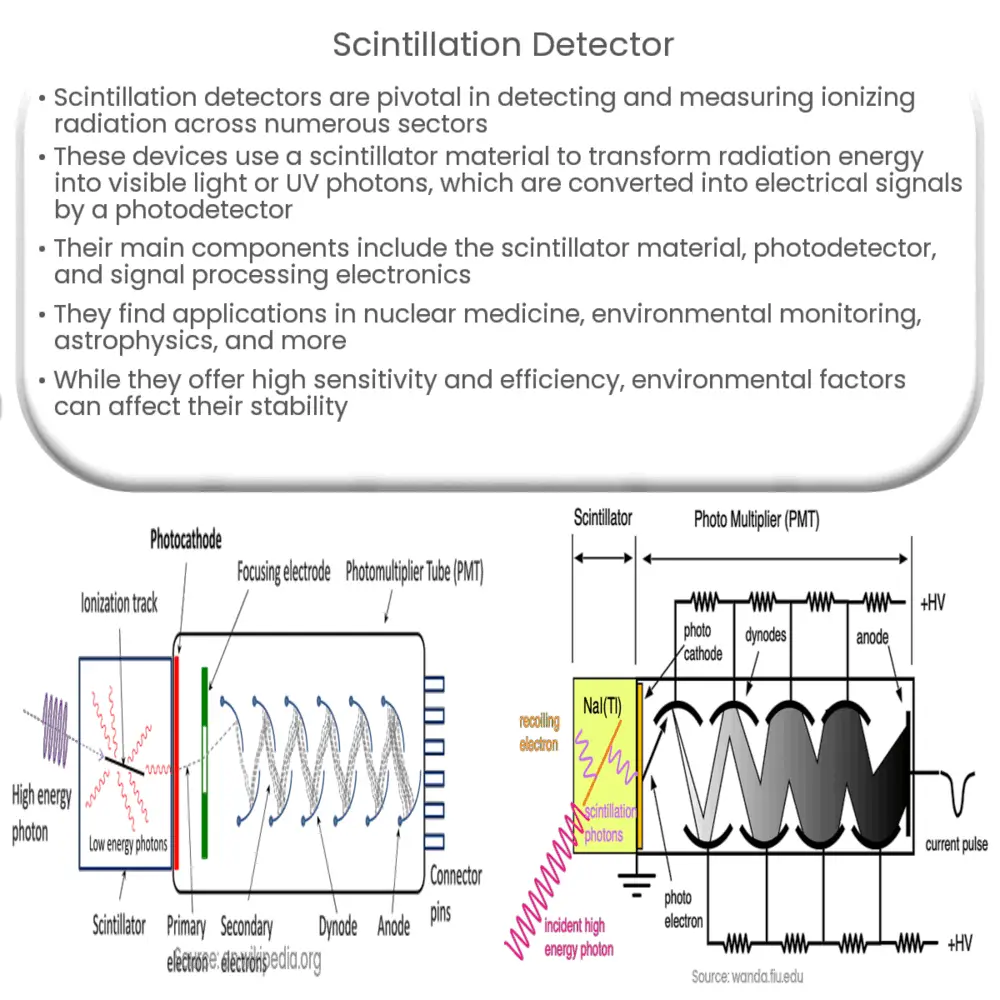A scintillation detector detects ionizing radiation using a scintillator material, which converts radiation energy into light, enabling precise measurements.

Scintillation Detector: Unveiling the Mysteries of Radiation
Introduction
Scintillation detectors are essential tools in the world of radiation detection and measurement. These sophisticated devices are widely used in various industries, research fields, and medical applications for detecting and quantifying ionizing radiation. In this article, we will explore the fundamentals of scintillation detectors, their working principles, and their applications in different domains.
What is a Scintillation Detector?
A scintillation detector is a device that uses a scintillator material to detect ionizing radiation, such as gamma rays, X-rays, or charged particles. The scintillator material is a key component of the detector and is responsible for converting the energy of incoming radiation into visible light or ultraviolet (UV) photons. These emitted photons are then collected and processed by a photodetector, which generates an electrical signal proportional to the energy of the incident radiation.
Components of a Scintillation Detector
A typical scintillation detector consists of three main components:
- Scintillator material: The core component of the detector, responsible for producing light or UV photons upon interaction with ionizing radiation. Scintillator materials can be classified into two main types: inorganic and organic. Inorganic scintillators, such as sodium iodide (NaI) and cesium iodide (CsI), are generally more efficient and have better energy resolution, but may be more expensive and less durable than organic scintillators, like plastic or liquid scintillators.
- Photodetector: This component is responsible for converting the emitted light or UV photons from the scintillator into an electrical signal. The most commonly used photodetectors are photomultiplier tubes (PMTs) and silicon photomultipliers (SiPMs). PMTs are known for their high sensitivity and low noise, while SiPMs offer compactness, lower voltage requirements, and insensitivity to magnetic fields.
- Signal processing and readout electronics: The electrical signal generated by the photodetector is processed and analyzed by the readout electronics. This system may include amplifiers, filters, analog-to-digital converters (ADCs), and other components required for signal processing and data acquisition.
Working Principle of a Scintillation Detector
When ionizing radiation interacts with the scintillator material, it deposits energy into the material, causing its atoms or molecules to become excited. This excitation leads to the emission of light or UV photons, which are then collected by the photodetector. The photodetector generates an electrical signal proportional to the number of emitted photons, which, in turn, is proportional to the energy of the incident radiation. This electrical signal is then processed and analyzed by the readout electronics, providing valuable information about the energy, intensity, and sometimes the type of the detected radiation.
Applications of Scintillation Detectors
Scintillation detectors have a wide range of applications across various industries and research fields. Some of the most common applications include:
- Nuclear Medicine: Scintillation detectors play a crucial role in medical imaging techniques such as single-photon emission computed tomography (SPECT) and positron emission tomography (PET). These imaging modalities rely on scintillation detectors to capture and quantify the radiation emitted by radiopharmaceuticals, providing essential diagnostic information for physicians.
- Radiation Protection: In industries where workers are exposed to ionizing radiation, scintillation detectors are employed to monitor and measure radiation levels, ensuring the safety of personnel and compliance with regulatory requirements.
- Environmental Monitoring: Scintillation detectors are used to monitor and measure environmental radiation levels, particularly in the vicinity of nuclear power plants, radioactive waste storage facilities, and other sources of ionizing radiation.
- Astrophysics and Space Research: Scintillation detectors are utilized in space missions and ground-based observatories to study cosmic radiation, gamma-ray bursts, and other high-energy astronomical phenomena.
- Homeland Security and Border Control: Scintillation detectors are employed in radiation portal monitors and handheld devices to detect and prevent the illicit trafficking of radioactive materials and potential threats related to nuclear or radiological terrorism.
- Particle Physics and Nuclear Research: In research facilities like particle accelerators and nuclear reactors, scintillation detectors are essential tools for studying fundamental particle interactions, nuclear reactions, and other phenomena in the field of high-energy physics.
Advantages and Limitations
Scintillation detectors offer several advantages over other types of radiation detectors, such as gas-filled detectors and semiconductor detectors. Some of the main benefits include:
- High sensitivity and detection efficiency
- Fast response time, allowing for the detection of short-lived events or high counting rates
- Ability to measure a broad range of energies and types of ionizing radiation
- Good energy resolution, enabling the discrimination of different radiation energies or types
Despite their advantages, scintillation detectors also have some limitations:
- Scintillator materials can be sensitive to temperature, humidity, and other environmental factors, which may affect their performance and long-term stability
- Organic scintillators may degrade over time due to radiation damage or other factors, leading to reduced performance and the need for replacement
- The size and weight of certain scintillation detectors, particularly those using PMTs, can be a drawback for portable or space-constrained applications
Conclusion
Scintillation detectors are vital tools in the detection and measurement of ionizing radiation, with applications spanning various industries, research fields, and medical practices. Understanding their working principles, components, and advantages and limitations is essential for selecting the most suitable detector for a given application and optimizing its performance for accurate and reliable radiation measurements.

